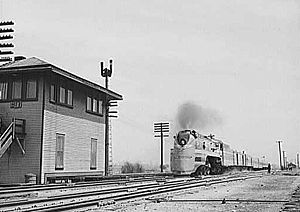- Milwaukee Road class F7
-
Milwaukee Road class F7 
Class F7 leading the Midwest Hiawatha past Tower B17, Bensenville, Illinois, May 1943 Power type Steam Builder American Locomotive Company Serial number 69064–69069 Build date August to September 1938 Total produced 6 Gauge 4 ft 8 1⁄2 in (1,435 mm) Driver diameter 84 in (2,134 mm) Wheelbase Loco & tender: 89 ft 10 in (27.38 m) Length 100 ft 0 in (30.48 m) Axle load 72,250 lb (32.8 tonnes) Weight on drivers 216,000 lb (98.0 tonnes) Locomotive & tender
combined weight791,000 lb (358.8 t) Fuel type Coal Fuel capacity 50,000 lb (22.7 tonnes) Water capacity 16,700 US gal (63,200 l; 13,900 imp gal) Boiler pressure 300 lbf/in² (2.07 MPa) Firegrate area 96.5 sq ft (8.97 m2) Heating surface:
Total4,166 sq ft (387.0 m2) Superheater area 1,695 sq ft (157.5 m2) Cylinders Two, outside Cylinder size 23.5 × 30 in (597 × 762 mm) Tractive effort 50,294 lbf (223.72 kN) Career Milwaukee Road Number 100–105 Retired November 1949 to August 1951 Disposition All scrapped The Milwaukee Road's class F7 comprised six (#100–#105) high-speed, streamlined 4-6-4 "Baltic" or "Hudson" type steam locomotives built by ALCO in 1937–38 to haul the Milwaukee's Hiawatha express passenger trains. Following on from the success of the road's class A 4-4-2s, the F7s allowed the road to haul longer trains on the popular Chicago–Twin Cities routes.
The F7s are major contenders for the fastest steam locomotives ever built, as they ran at over 100 miles per hour (160 km/h) daily. One run in January 1941 recorded by a reporter for Trains magazine saw 110 mph achieved twice—in the midst of a heavy snowstorm. Baron Gérard Vuillet, a French railroading expert, once recorded a run between Chicago and Milwaukee where the locomotive reached 125 mph (201 km/h) and sustained an average 120 mph (190 km/h) for 4.5 miles (7.2 km).[1] However, the British locomotive LNER Class A4 4468 Mallard is officially accepted to be the world's fastest, with a run recorded at 125.88 mph (202.58 km/h) in 1938.
The Milwaukee F7s are accepted as the fastest steam locomotives by a different measure—scheduled speed between stations. In 1939, shortly after they were introduced into passenger service, the Twin Cities Hiawatha schedule was modified such that the engines would need to run the 78.3 mi (126.0 km) between Portage and Sparta, Wisconsin in 58 minutes—a start-to-stop average of 81 mph (130 km/h).[1]
First-built #100 was also the first withdrawn from service, on November 10, 1949; last-built #105 was the final one in service, withdrawn August 10, 1951.
See also
- CNW Class E-4 - nine very similar 4-6-4 locomotives built for the Milwaukee's Chicago competitor, the Chicago and North Western Railway.
References
- Benn, Bryan. "Fastest Steam Locomotive". http://www.germansteam.co.uk/FastestLoco/fastestloco.html#MR1. Retrieved 2010-02-05.
- Edson, William D. (Spring 1977). "Milwaukee Road Locomotives". Railroad History (The Railway and Locomotive Historical Society, Inc.) (136): pp. 28–129.
- Hollingsworth, Brian; Cook, Arthur (2001). The Great Book of Trains. Osceola, Wisconsin: MBI Publishing. ISBN 0-7603-1193-5.
- King, Ed; Scribbins, Jim (Spring 2002). Classic Trains (Kalmbach Publishing Co.) Vol. 3 (No. 1): pp. 65–73.
- Reed, Brian (1972). Loco Profile 26 – The Hiawathas. Windsor, Berkshire, UK: Profile Publications Ltd.
- Ross, Don. "Chicago Milwaukee St. Paul & Pacific: 4-6-4s". Don's Rail Photos. http://donsdepot.donrossgroup.net/dr485.htm. Retrieved 2011-11-07.

This steam locomotive-related article is a stub. You can help Wikipedia by expanding it.

